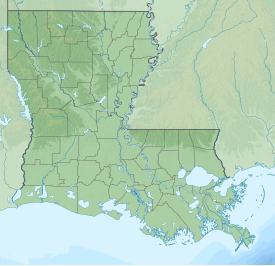
The Battle of Mansfield, also known as the Battle of Sabine Crossroads, on April 8, 1864, in Louisiana formed part of the Red River Campaign during the American Civil War, when Union forces were attempting to occupy the Louisiana state capital, Shreveport.

The Battle of Front Royal, also known as Guard Hill or Cedarville, was fought on May 23, 1862, during the American Civil War, as part of Jackson's Valley campaign. Confederate forces commanded by Major General Thomas J. "Stonewall" Jackson were trying to keep Union forces engaged in the Shenandoah Valley to prevent them from joining the Peninsula campaign. After defeating Major General John C. Frémont's force in the Battle of McDowell, Jackson turned against the forces of Major General Nathaniel Banks.
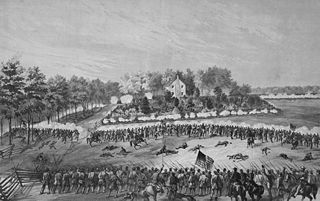
The Battle of Jackson was fought on May 14, 1863, in Jackson, Mississippi, as part of the Vicksburg campaign during the American Civil War. After entering the state of Mississippi in late April 1863, Major General Ulysses S. Grant of the Union Army moved his force inland to strike at the strategic Mississippi River town of Vicksburg, Mississippi. The Battle of Raymond, which was fought on May 12, convinced Grant that General Joseph E. Johnston's Confederate army was too strong to be safely bypassed, so he sent two corps, under major generals James B. McPherson and William T. Sherman, to capture Johnston's position at Jackson. Johnston did not believe the city was defensible and began withdrawing. Brigadier General John Gregg was tasked with commanding the Confederate rear guard, which fought Sherman's and McPherson's men at Jackson on May 14 before withdrawing. After taking the city, Union troops destroyed economic and military infrastructure and also plundered civilians' homes. Grant then moved against Vicksburg, which he placed under siege on May 18 and captured on July 4. Despite being reinforced, Johnston made only a weak effort to save the Vicksburg garrison, and was driven out of Jackson a second time in mid-July.
The Battle of Fort Davidson, also known as the Battle of Pilot Knob, was a battle of Price's Missouri Expedition fought on September 27, 1864, near Pilot Knob, Missouri. Confederate troops under the command of Major-General Sterling Price had entered Missouri in September 1864 with hopes of challenging Union control of the state. On September 24, Price learned that Union troops held Pilot Knob. Two days later, he sent part of his command north to disrupt and then moved towards Pilot Knob with the rest of his army. The Confederate divisions of Major-General James Fagan and Brigadier-General John Marmaduke drove Union troops under Brigadier-General Thomas Ewing and Major James Wilson from the lower Arcadia Valley into Fort Davidson on September 26 and on the morning of September 27.
The Battle of Roan's Tan Yard, also known as the Battle of Silver Creek, was a minor battle fought during the American Civil War on January 8, 1862, in Randolph County, Missouri. After back-and-forth operations throughout 1861, the pro-Confederate Missouri State Guard under the command of Sterling Price had been confined to southwestern Missouri. In December 1861, Price authorized recruiting and raiding activities in the central portion of the state, with the North Missouri Railroad being a major target. In January 1862, Major W. M. G. Torrence of the Union Army located a Missouri State Guard base in Randolph County and attacked it on January 8 with elements of four cavalry regiments. The camp, which was commanded by Colonel John A. Poindexter, put up little resistance and was soon overrun. Large quantities of supplies were captured in the abandoned camp, which was destroyed. The action at Roan's Tan Yard, along with a Missouri State Guard defeat at the Battle of Mount Zion Church the preceding December, led to a decrease in pro-Confederate activity in central Missouri.

The Battle of Milliken's Bend was fought on June 7, 1863, as part of the Vicksburg Campaign during the American Civil War. Major General Ulysses S. Grant of the Union Army had placed the strategic Mississippi River city of Vicksburg, Mississippi, under siege in mid-1863. Confederate leadership erroneously believed that Grant's supply line still ran through Milliken's Bend in Louisiana, and Major General Richard Taylor was tasked with disrupting it to aid the defense of Vicksburg. Taylor sent Brigadier General Henry E. McCulloch with a brigade of Texans to attack Milliken's Bend, which was held by a brigade of newly-recruited African American soldiers. McCulloch's attack struck early on the morning of June 7, and was initially successful in close-quarters fighting. Fire from the Union gunboat USS Choctaw halted the Confederate attack, and McCulloch later withdrew after the arrival of a second gunboat. The attempt to relieve Vicksburg was unsuccessful. One of the first actions in which African American soldiers fought, Milliken's Bend demonstrated the value of African American soldiers as part of the Union Army.
The Battle of Plains Store was fought on May 21, 1863, in East Baton Rouge Parish, Louisiana, during the campaign to capture Port Hudson in the American Civil War. Union troops advancing from Baton Rouge, Louisiana, clashed with 600 Confederates at a road junction. The initial Confederate force withdrew, but 400 more Confederates arrived from Port Hudson. Some of the Confederate reinforcement overran Union artillery and routed a Union regiment, but were unable to capture the guns. Union reinforcements advanced to the front, attacked part of the Confederate force and drove them from the field. The Confederates withdrew to Port Hudson, which was almost entirely surrounded by Union troops the next day. Port Hudson was under siege until the defenders surrendered on July 9.
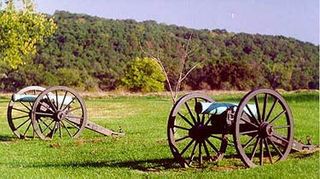
Wilson's Creek National Battlefield, located near Republic, Missouri, preserves the site of the Battle of Wilson's Creek. Fought on August 10, 1861, the battle was the first major American Civil War engagement west of the Mississippi River. In the battle, a Confederate army commanded by Benjamin McCulloch and Sterling Price defeated a smaller Union army commanded by Nathaniel Lyon. However, the Confederates were unable to hold much of Missouri, and a Confederate defeat at the Battle of Pea Ridge effectively solidified Union control of the state. Major features include a five-mile automobile tour loop, the restored 1852 Ray House, and "Bloody Hill", the site of the final stage of the battle. The site is located near Republic in southwestern Missouri just southwest of the city of Springfield. It has been a unit of the National Park Service since 1960, and was listed on the National Register of Historic Places in 1966.

The Battle of Raymond was fought on May 12, 1863, near Raymond, Mississippi, during the Vicksburg campaign of the American Civil War. Initial Union attempts to capture the strategically important Mississippi River city of Vicksburg failed. Beginning in late April 1863, Union Major General Ulysses S. Grant led another try. After crossing the river into Mississippi and winning the Battle of Port Gibson, Grant began moving east, intending to turn back west and attack Vicksburg. A portion of Grant's army consisting of Major General James B. McPherson's 10,000 to 12,000-man XVII Corps moved northeast towards Raymond. The Confederate commander of Vicksburg, Lieutenant General John C. Pemberton, ordered Brigadier General John Gregg and his 3,000 to 4,000-strong brigade from Jackson to Raymond.

The Battle of Grand Gulf was fought on April 29, 1863, during the American Civil War. Union Army forces commanded by Major General Ulysses S. Grant had failed several times to bypass or capture the Confederate-held city of Vicksburg, Mississippi, during the Vicksburg campaign. Grant decided to move his army south of Vicksburg, cross the Mississippi River, and then advance on the city. A Confederate Army division under Brigadier General John S. Bowen prepared defenses—Forts Wade and Cobun—at Grand Gulf, Mississippi, south of Vicksburg. To clear the way for a Union crossing, seven Union Navy ironclad warships from the Mississippi Squadron commanded by Admiral David Dixon Porter bombarded the Confederate defenses at Grand Gulf on April 29. Union fire silenced Fort Wade and killed its commander, but the overall Confederate position held. Grant decided to cross the river elsewhere.

The Battle of Pleasant Hill on April 9, 1864, in Louisiana formed part of the Red River Campaign during the American Civil War, when Union forces were attempting to occupy the Louisiana state capital, Shreveport.
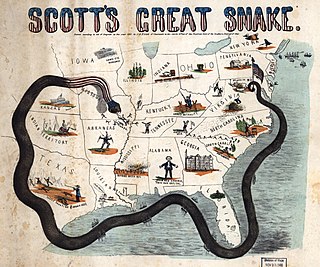
The lower seaboard theater of the American Civil War encompassed major military and naval operations that occurred near the coastal areas of the Southeastern United States: in Alabama, Florida, Louisiana, Mississippi, South Carolina, and Texas) as well as southern part of the Mississippi River.
The following engagements took place in the year 1864 during the American Civil War. The Union armies, under the command of U.S. Grant, launched multiple offenses in all theaters of the war, in an attempt to prevent Confederate forces from transferring troops from one army to another.

The following Confederate Army units and commanders fought in the Battle of Raymond; the Union order of battle is listed separately.

The Battle of Lake Providence was fought on June 9, 1863, during the Vicksburg campaign of the American Civil War. Confederate troops from the Trans-Mississippi Department were trying to relieve Union pressure during the Siege of Vicksburg. Major General Richard Taylor, primarily utilizing Walker's Greyhounds, prepared a three-pronged attack against Union positions at Milliken's Bend, Young's Point, and Lake Providence. The strike against Lake Providence was conducted by 900 men led by Colonel Frank Bartlett.
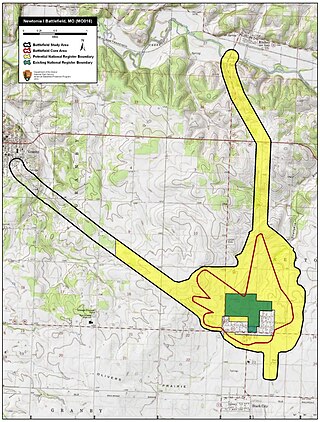
The First Battle of Newtonia Historic District, near Newtonia, Missouri, is a National Register of Historic Places (NRHP) site that preserves the location of the First Battle of Newtonia, an 1862 battle during the American Civil War. The battle saw Confederate troops under Colonels Douglas H. Cooper and Joseph O. Shelby defeat a Union force commanded by Brigadier General Frederick Salomon. The historic district contains some Civil War-period structures, as well as the Mathew H. Ritchey House, which is listed separately on the NRHP.
The 4th Missouri Infantry Regiment was formed on April 28, 1862, and served in the Confederate States Army during the American Civil War. The infantry regiment did not see action at the Battle of Farmington on May 9, and the Battle of Iuka on September 19 despite being part of the Confederate force present at those battles. As part of Brigadier General Martin E. Green's brigade, the regiment participated in three charges against Union lines on October 3, 1862, during the Second Battle of Corinth. The following day, the regiment, along with the rest of Green's brigade, attacked the new Union lines. Despite initial success, the attack was repulsed by a Union counterattack. The regiment ceased to exist as a separate unit when it was combined with the 1st Missouri Infantry Regiment on November 7, 1862, to form the 1st and 4th Missouri Infantry Regiment (Consolidated).

The 8th Missouri Infantry Regiment was an infantry regiment of the Confederate States Army during the American Civil War. From May 1861, the war began affecting events in the state of Missouri. In 1862, Confederate recruiting activities took place in Missouri, and a cavalry regiment was formed in Oregon County, the nucleus being former members of the Missouri State Guard. On September 2, the unit entered Confederate service, but it was reclassified as infantry ten days later. After many of the men transferred to other units, the regiment was reclassified as a battalion on October 19 and named the 7th Missouri Infantry Battalion, also known as Mitchell's Missouri Infantry. It participated in a Confederate offensive at the Battle of Prairie Grove on December 7. During the battle, the unit made several charges against the Union lines but was repeatedly repulsed by artillery fire. The regiment spent most of early 1863 encamped near Little Rock and Pine Bluff in Arkansas.

Barrett's Missouri Battery was an artillery battery that served in the Confederate States Army during the American Civil War. After entering Confederate service on April 1, 1862, the unit was armed with two 6-pounder smoothbore cannons and two 12-pounder howitzers and was commanded by Captain Overton W. Barrett. It was present during the Siege of Corinth, but saw no action. During the Battle of Perryville in October 1862, Barrett's battery provided artillery support for a Confederate brigade. After spending the next several months moving around Tennessee, the battery supported a Confederate attack during the Battle of Stones River in December. The 1863 Chickamauga campaign brought light action for the unit, which also fought in the Battle of Missionary Ridge. When the Confederates retreated after the Missionary Ridge fighting, Barrett's battery was part of the Confederate rear guard at the Battle of Ringgold Gap, earning the praise of Patrick R. Cleburne. Rearmed with four 12-pounder howitzers, the unit was action in the 1864 Atlanta campaign as part of the Confederate reserve artillery, although two of the cannons were lost to attrition. On April 16, 1865, the battery ceased to exist when its flag, cannons, and most of its members were captured during the Battle of Columbus, Georgia. As of January 2021, its battle flag is part of the collection of the Missouri State Museum.

The 9th Missouri Sharpshooter Battalion, also known as Pindall's Missouri Sharpshooter Battalion, was a unit that served in the Confederate States Army during the American Civil War. The battalion was formed in late 1862, in compliance with an earlier authorization by the Confederate States Congress for each brigade to have an associated battalion of sharpshooters. When first formed, the men had no unique qualifications to serve as sharpshooters and were drawn from a defunct artillery battery, a partisan rangers unit, and infantrymen. The unit's first major battle was the Battle of Prairie Grove in December 1862.
